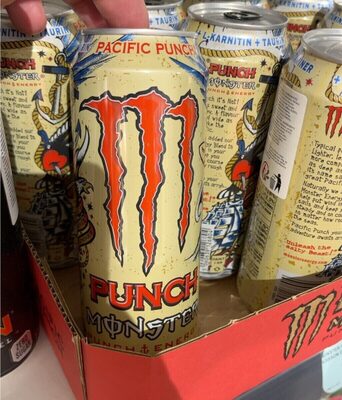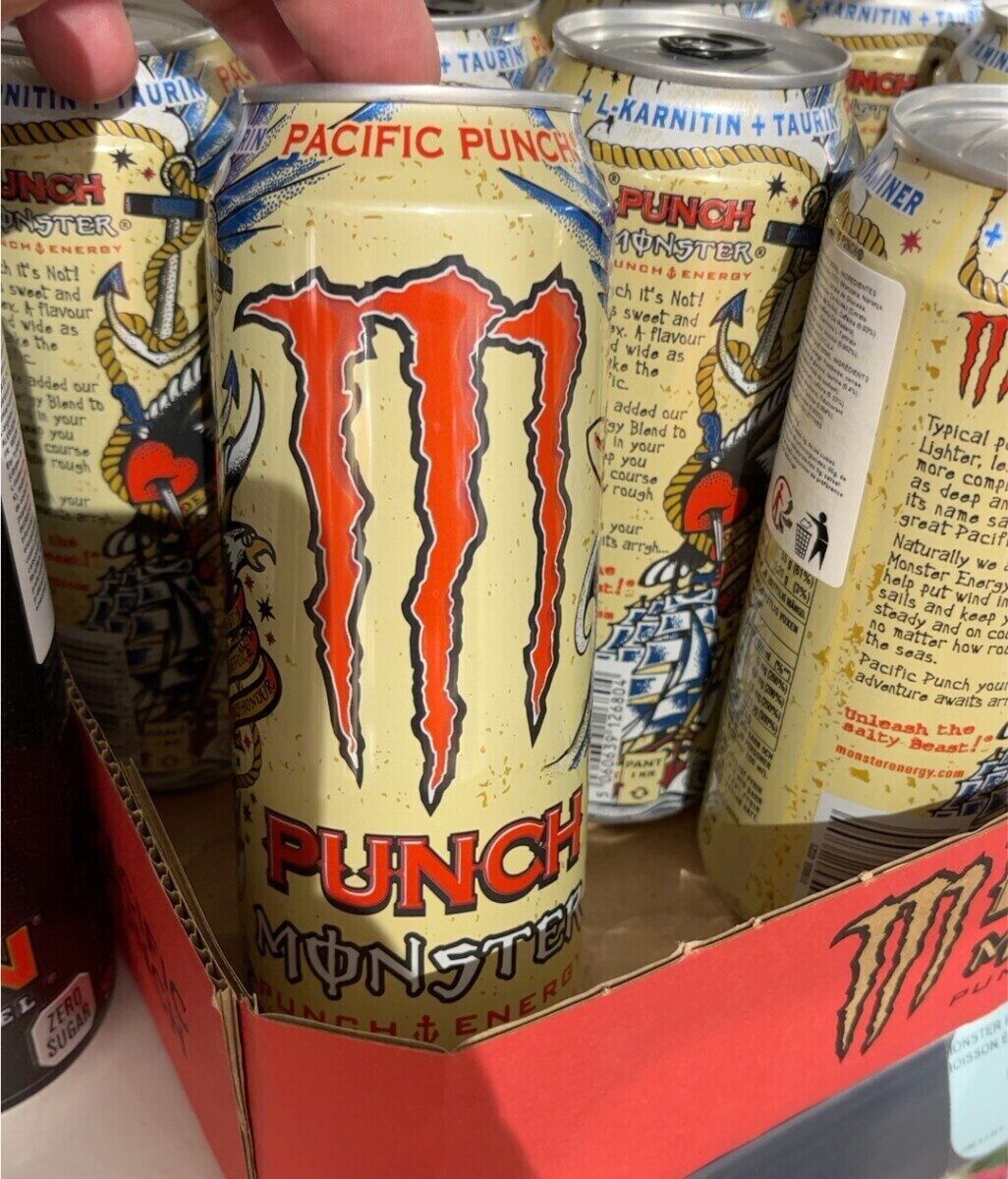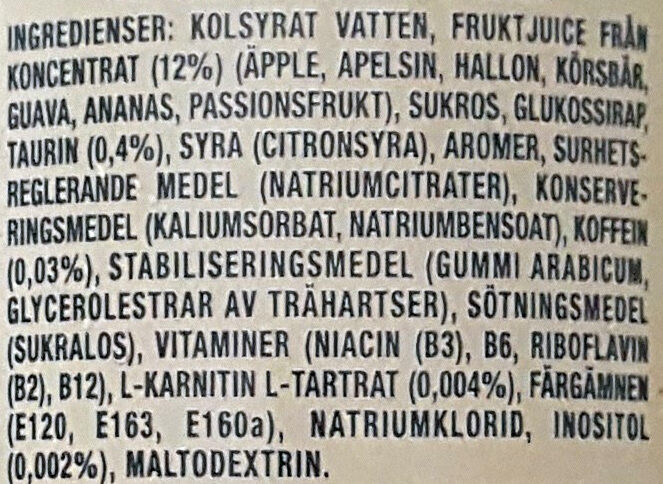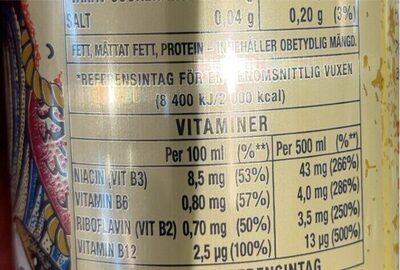Help us make food transparency the norm!
As a non-profit organization, we depend on your donations to continue informing consumers around the world about what they eat.
The food revolution starts with you!
Punch monster - 500 ml
Punch monster - 500 ml
This product page is not complete. You can help to complete it by editing it and adding more data from the photos we have, or by taking more photos using the app for Android or iPhone/iPad. Thank you!
×
Streckkod: 5060639126804 (EAN / EAN-13)
Vanligt namn: Kolsyrad fruktenergidryck med taurin, koffein, L-karnitin, insitol och B-vitaminer med socker och sötningsmedel.
Kvantitet: 500 ml
Förpackning: en:Metal, Återvinningsbara metaller, Aluminium, Aluminum
Varumärken: Monster, Monster Energy
Kategorier: Växtbaserad mat och dryck, Drycker, Växtbaserade drycker, Fruktbaserade drycker, Energidrycker, en:Beverages with orange, en:Energy drink with sugar, en:Sweetened beverages
Etiketter, certifieringar, utmärkelser:
en:Not advised for specific people, en:Not advised for children and pregnant women, en:Not advised for pregnant women, en:Not recommended for children under 3 years, en:Alu
Länk till produktsidan på producentens officiella webbplats: https://www.monsterenergy.com/se/en/prod...
Butiker: Coop
Länder där såld: Sverige
Matching with your preferences
Hälsa
Ingredienser
-
41 ingredienser
KOLSYRAT VATTEN, FRUKTJUICE FRÅN KONCENTRAT (12%) (ÄPPLE, APELSIN, HALLON, KÖRSBÄR, GUAVA, ANANAS, PASSIONSFRUKT), SUKROS, GLUKOSSIRAP, TAURIN (0,4%), SYRA (CITRONSYRA), AROMER, SURHETSREGLERANDE MEDEL (NATRIUMCITRATER), KONSERVERINGSMEDEL (KALIUMSORBAT, NATRIUMBENSOAT), KOFFEIN (0,03%), STABILISERINGSMEDEL (GUMMI ARABICUM, GLYCEROLESTRAR AV TRÄHARTSER), SÖTNINGSMEDEL (SUKRALOS), VITAMINER (NIACIN (B3), B6, RIBOFLAVIN (B2), B12), L-KARNITIN L-TARTRAT (0,004%), FÄRGÄMNEN (E120, E163, E160a), NATRIUMKLORID, INOSITOL (0,002%), MALTODEXTRIN.Allergener: en:Apple
Food processing
-
Ultra processed foods
Elements that indicate the product is in the 4 - Ultra bearbetade livsmedel och drycker group:
- Tillsats: E120 - Karmin
- Tillsats: E160a - Karoten
- Tillsats: E163 - Antocyaner
- Tillsats: E414 - Gummi arabicum
- Tillsats: E445 - Glycerolestrar av trähartser
- Tillsats: E955 - Sukralos
- Ingrediens: Färg
- Ingrediens: Arom
- Ingrediens: Glukos
- Ingrediens: Glukossirap
- Ingrediens: Maltodextriner
- Ingrediens: Sötningsmedel
- Ingrediens: Fruktjuicekoncentrat
Food products are classified into 4 groups according to their degree of processing:
- Obearbetade eller minimalt bearbetade livsmedel
- Bearbetade kulinariska ingredienser
- Halvfabrikat
- Ultra processed foods
The determination of the group is based on the category of the product and on the ingredients it contains.
Tillsatser
-
E120 - Karmin
Carminic acid: Carminic acid -C22H20O13- is a red glucosidal hydroxyanthrapurin that occurs naturally in some scale insects, such as the cochineal, Armenian cochineal, and Polish cochineal. The insects produce the acid as a deterrent to predators. An aluminum salt of carminic acid is the coloring agent in carmine. Synonyms are C.I. 75470 and C.I. Natural Red 4. The chemical structure of carminic acid consists of a core anthraquinone structure linked to a glucose sugar unit. Carminic acid was first synthesized in the laboratory by organic chemists in 1991.Källa: Wikipedia (Engelska)
-
E160a - Karoten
Carotene: The term carotene -also carotin, from the Latin carota, "carrot"- is used for many related unsaturated hydrocarbon substances having the formula C40Hx, which are synthesized by plants but in general cannot be made by animals -with the exception of some aphids and spider mites which acquired the synthesizing genes from fungi-. Carotenes are photosynthetic pigments important for photosynthesis. Carotenes contain no oxygen atoms. They absorb ultraviolet, violet, and blue light and scatter orange or red light, and -in low concentrations- yellow light. Carotenes are responsible for the orange colour of the carrot, for which this class of chemicals is named, and for the colours of many other fruits, vegetables and fungi -for example, sweet potatoes, chanterelle and orange cantaloupe melon-. Carotenes are also responsible for the orange -but not all of the yellow- colours in dry foliage. They also -in lower concentrations- impart the yellow coloration to milk-fat and butter. Omnivorous animal species which are relatively poor converters of coloured dietary carotenoids to colourless retinoids have yellowed-coloured body fat, as a result of the carotenoid retention from the vegetable portion of their diet. The typical yellow-coloured fat of humans and chickens is a result of fat storage of carotenes from their diets. Carotenes contribute to photosynthesis by transmitting the light energy they absorb to chlorophyll. They also protect plant tissues by helping to absorb the energy from singlet oxygen, an excited form of the oxygen molecule O2 which is formed during photosynthesis. β-Carotene is composed of two retinyl groups, and is broken down in the mucosa of the human small intestine by β-carotene 15‚15'-monooxygenase to retinal, a form of vitamin A. β-Carotene can be stored in the liver and body fat and converted to retinal as needed, thus making it a form of vitamin A for humans and some other mammals. The carotenes α-carotene and γ-carotene, due to their single retinyl group -β-ionone ring-, also have some vitamin A activity -though less than β-carotene-, as does the xanthophyll carotenoid β-cryptoxanthin. All other carotenoids, including lycopene, have no beta-ring and thus no vitamin A activity -although they may have antioxidant activity and thus biological activity in other ways-. Animal species differ greatly in their ability to convert retinyl -beta-ionone- containing carotenoids to retinals. Carnivores in general are poor converters of dietary ionone-containing carotenoids. Pure carnivores such as ferrets lack β-carotene 15‚15'-monooxygenase and cannot convert any carotenoids to retinals at all -resulting in carotenes not being a form of vitamin A for this species-; while cats can convert a trace of β-carotene to retinol, although the amount is totally insufficient for meeting their daily retinol needs.Källa: Wikipedia (Engelska)
-
E163 - Antocyaner
Anthocyanin: Anthocyanins -also anthocyans; from Greek: ἄνθος -anthos- "flower" and κυάνεος/κυανοῦς kyaneos/kyanous "dark blue"- are water-soluble vacuolar pigments that, depending on their pH, may appear red, purple, or blue. Food plants rich in anthocyanins include the blueberry, raspberry, black rice, and black soybean, among many others that are red, blue, purple, or black. Some of the colors of autumn leaves are derived from anthocyanins.Anthocyanins belong to a parent class of molecules called flavonoids synthesized via the phenylpropanoid pathway. They occur in all tissues of higher plants, including leaves, stems, roots, flowers, and fruits. Anthocyanins are derived from anthocyanidins by adding sugars. They are odorless and moderately astringent. Although approved to color foods and beverages in the European Union, anthocyanins are not approved for use as a food additive because they have not been verified as safe when used as food or supplement ingredients. There is no conclusive evidence anthocyanins have any effect on human biology or diseases.Källa: Wikipedia (Engelska)
-
E202 - Kaliumsorbat
Potassium sorbate: Potassium sorbate is the potassium salt of sorbic acid, chemical formula CH3CH=CH−CH=CH−CO2K. It is a white salt that is very soluble in water -58.2% at 20 °C-. It is primarily used as a food preservative -E number 202-. Potassium sorbate is effective in a variety of applications including food, wine, and personal-care products. While sorbic acid is naturally occurring in some berries, virtually all of the world's production of sorbic acid, from which potassium sorbate is derived, is manufactured synthetically.Källa: Wikipedia (Engelska)
-
E211 - Natriumbensoat
Sodium benzoate: Sodium benzoate is a substance which has the chemical formula NaC7H5O2. It is a widely used food preservative, with an E number of E211. It is the sodium salt of benzoic acid and exists in this form when dissolved in water. It can be produced by reacting sodium hydroxide with benzoic acid.Källa: Wikipedia (Engelska)
-
E330 - Citronsyra
Citric acid: Citric acid is a weak organic acid that has the chemical formula C6H8O7. It occurs naturally in citrus fruits. In biochemistry, it is an intermediate in the citric acid cycle, which occurs in the metabolism of all aerobic organisms. More than a million tons of citric acid are manufactured every year. It is used widely as an acidifier, as a flavoring and chelating agent.A citrate is a derivative of citric acid; that is, the salts, esters, and the polyatomic anion found in solution. An example of the former, a salt is trisodium citrate; an ester is triethyl citrate. When part of a salt, the formula of the citrate ion is written as C6H5O3−7 or C3H5O-COO-3−3.Källa: Wikipedia (Engelska)
-
E331 - Natriumcitrater
Sodium citrate: Sodium citrate may refer to any of the sodium salts of citrate -though most commonly the third-: Monosodium citrate Disodium citrate Trisodium citrateThe three forms of the salt are collectively known by the E number E331. Sodium citrates are used as acidity regulators in food and drinks, and also as emulsifiers for oils. They enable cheeses to melt without becoming greasy.Källa: Wikipedia (Engelska)
-
E414 - Gummi arabicum
Gum arabic: Gum arabic, also known as acacia gum, arabic gum, gum acacia, acacia, Senegal gum and Indian gum, and by other names, is a natural gum consisting of the hardened sap of various species of the acacia tree. Originally, gum arabic was collected from Acacia nilotica which was called the "gum arabic tree"; in the present day, gum arabic is collected from acacia species, predominantly Acacia senegal and Vachellia -Acacia- seyal; the term "gum arabic" does not indicate a particular botanical source. In a few cases so‐called "gum arabic" may not even have been collected from Acacia species, but may originate from Combretum, Albizia or some other genus. Producers harvest the gum commercially from wild trees, mostly in Sudan -80%- and throughout the Sahel, from Senegal to Somalia—though it is historically cultivated in Arabia and West Asia. Gum arabic is a complex mixture of glycoproteins and polysaccharides. It is the original source of the sugars arabinose and ribose, both of which were first discovered and isolated from it, and are named after it. Gum arabic is soluble in water. It is edible, and used primarily in the food industry as a stabilizer, with EU E number E414. Gum arabic is a key ingredient in traditional lithography and is used in printing, paint production, glue, cosmetics and various industrial applications, including viscosity control in inks and in textile industries, though less expensive materials compete with it for many of these roles. While gum arabic is now produced throughout the African Sahel, it is still harvested and used in the Middle East.Källa: Wikipedia (Engelska)
-
E445 - Glycerolestrar av trähartser
Glycerol ester of wood rosin: Glycerol ester of wood rosin, also known as glyceryl abietate or ester gum, is an oil-soluble food additive -E number E445-. The food-grade material is used in foods, beverages, and cosmetics to keep oils in suspension in water, and its name may be shortened in the ingredient list as glycerol ester of rosin. It is also used as an ingredient in the production of chewing-gum and ice cream. Similar, less pure materials -glycerol ester of gum rosin- are used as a component of certain low-cost adhesives.To make the glycerol ester of wood rosin, refined wood rosin is reacted with glycerin to produce the glycerol ester. Glycerol ester of wood rosin is an alternative to brominated vegetable oil in citrus oil-flavored soft drinks. In some cases, both ingredients are used together.Källa: Wikipedia (Engelska)
-
E955 - Sukralos
Sucralose: Sucralose is an artificial sweetener and sugar substitute. The majority of ingested sucralose is not broken down by the body, so it is noncaloric. In the European Union, it is also known under the E number E955. It is produced by chlorination of sucrose. Sucralose is about 320 to 1‚000 times sweeter than sucrose, three times as sweet as both aspartame and acesulfame potassium, and twice as sweet as sodium saccharin. Evidence of benefit is lacking for long-term weight loss with some data supporting weight gain and heart disease risks.It is stable under heat and over a broad range of pH conditions. Therefore, it can be used in baking or in products that require a long shelf life. The commercial success of sucralose-based products stems from its favorable comparison to other low-calorie sweeteners in terms of taste, stability, and safety. Common brand names of sucralose-based sweeteners are Splenda, Zerocal, Sukrana, SucraPlus, Candys, Cukren, and Nevella. Canderel Yellow also contains sucralose, but the original Canderel and Green Canderel do not.Källa: Wikipedia (Engelska)
Ingrediensanalys
-
Kan innehålla palmolja
Ingredienser som kan innehålla palmolja: E160a
-
Icke-vegan
Non-vegan ingredients: L-karnitin-L-tartrat, E120
-
Icke-vegetarisk
Non-vegetarian ingredients: E120
-
Details of the analysis of the ingredients
sv: KOLSYRAT VATTEN, FRUKTJUICE FRÅN KONCENTRAT 12% (ÄPPLE, APELSIN, HALLON, KÖRSBÄR, GUAVA, ANANAS, PASSIONSFRUKT), SUKROS, GLUKOSSIRAP, TAURIN 0.4%, SYRA (CITRONSYRA), AROMER, SURHETSREGLERANDE MEDEL (NATRIUMCITRATER), KONSERVERINGSMEDEL (KALIUMSORBAT, NATRIUMBENSOAT), KOFFEIN 0.03%, STABILISERINGSMEDEL (GUMMI ARABICUM, GLYCEROLESTRAR AV TRÄHARTSER), SÖTNINGSMEDEL (SUKRALOS), vitaminer, NIACIN, vitamin B3, vitamin B6, RIBOFLAVIN (B2), B12, L-KARNITIN L-TARTRAT 0.004%, FÄRGÄMNEN (e120, e163, e160a), NATRIUMKLORID, INOSITOL 0.002%, MALTODEXTRIN- KOLSYRAT VATTEN -> en:carbonated-water - vegan: yes - vegetarian: yes - ciqual_food_code: 18066 - percent_min: 63.714 - percent_max: 86.608
- FRUKTJUICE FRÅN KONCENTRAT -> en:fruit-juice-from-concentrate - percent_min: 12 - percent: 12 - percent_max: 12
- ÄPPLE -> en:apple - vegan: yes - vegetarian: yes - ciqual_food_code: 13050 - percent_min: 1.71428571428571 - percent_max: 12
- APELSIN -> en:orange - vegan: yes - vegetarian: yes - ciqual_proxy_food_code: 13034 - percent_min: 0 - percent_max: 6
- HALLON -> en:raspberry - vegan: yes - vegetarian: yes - ciqual_food_code: 13015 - percent_min: 0 - percent_max: 4
- KÖRSBÄR -> en:cherry - vegan: yes - vegetarian: yes - ciqual_food_code: 13008 - percent_min: 0 - percent_max: 3
- GUAVA -> en:guava - vegan: yes - vegetarian: yes - percent_min: 0 - percent_max: 2.4
- ANANAS -> en:pineapple - vegan: yes - vegetarian: yes - percent_min: 0 - percent_max: 2
- PASSIONSFRUKT -> en:passionfruit - vegan: yes - vegetarian: yes - ciqual_food_code: 13016 - percent_min: 0 - percent_max: 1.71428571428571
- SUKROS -> en:sucrose - vegan: yes - vegetarian: yes - ciqual_proxy_food_code: 31016 - percent_min: 0.4 - percent_max: 11
- GLUKOSSIRAP -> en:glucose-syrup - vegan: yes - vegetarian: yes - ciqual_proxy_food_code: 31016 - percent_min: 0.4 - percent_max: 11
- TAURIN -> en:taurine - vegan: maybe - vegetarian: maybe - percent_min: 0.4 - percent: 0.4 - percent_max: 0.4
- SYRA -> en:acid - percent_min: 0.03 - percent_max: 0.4
- CITRONSYRA -> en:e330 - vegan: yes - vegetarian: yes - percent_min: 0 - percent_max: 0.4
- AROMER -> en:flavouring - vegan: maybe - vegetarian: maybe - percent_min: 0.03 - percent_max: 0.4
- SURHETSREGLERANDE MEDEL -> en:acidity-regulator - percent_min: 0.03 - percent_max: 0.4
- NATRIUMCITRATER -> en:e331 - vegan: yes - vegetarian: yes - percent_min: 0 - percent_max: 0.4
- KONSERVERINGSMEDEL -> en:preservative - percent_min: 0.03 - percent_max: 0.4
- KALIUMSORBAT -> en:e202 - vegan: yes - vegetarian: yes - percent_min: 0 - percent_max: 0.4
- NATRIUMBENSOAT -> en:e211 - vegan: yes - vegetarian: yes - percent_min: 0 - percent_max: 0.2
- KOFFEIN -> en:caffeine - vegan: yes - vegetarian: yes - percent_min: 0.03 - percent: 0.03 - percent_max: 0.03
- STABILISERINGSMEDEL -> en:stabiliser - percent_min: 0.004 - percent_max: 0.03
- GUMMI ARABICUM -> en:e414 - vegan: yes - vegetarian: yes - percent_min: 0 - percent_max: 0.03
- GLYCEROLESTRAR AV TRÄHARTSER -> en:e445 - vegan: yes - vegetarian: yes - percent_min: 0 - percent_max: 0.03
- SÖTNINGSMEDEL -> en:sweetener - percent_min: 0.004 - percent_max: 0.03
- SUKRALOS -> en:e955 - vegan: yes - vegetarian: yes - percent_min: 0 - percent_max: 0.03
- vitaminer -> en:vitamins - vegan: yes - vegetarian: yes - percent_min: 0.004 - percent_max: 0.03
- NIACIN -> en:e375 - vegan: maybe - vegetarian: maybe - percent_min: 0.004 - percent_max: 0.03
- vitamin B3 -> en:e375 - vegan: maybe - vegetarian: maybe - percent_min: 0.004 - percent_max: 0.03
- vitamin B6 -> en:vitamin-b6 - vegan: yes - vegetarian: yes - percent_min: 0.004 - percent_max: 0.03
- RIBOFLAVIN -> en:e101 - vegan: maybe - vegetarian: yes - percent_min: 0.004 - percent_max: 0.03
- B2 -> en:e101 - vegan: maybe - vegetarian: yes - percent_min: 0 - percent_max: 0.03
- B12 -> en:vitamin-b12 - percent_min: 0.004 - percent_max: 0.03
- L-KARNITIN L-TARTRAT -> en:l-carnitine-l-tartrate - vegan: no - vegetarian: maybe - percent_min: 0.004 - percent: 0.004 - percent_max: 0.004
- FÄRGÄMNEN -> en:colour - percent_min: 0.002 - percent_max: 0.004
- e120 -> en:e120 - vegan: no - vegetarian: no - percent_min: 0 - percent_max: 0.004
- e163 -> en:e163 - vegan: yes - vegetarian: yes - percent_min: 0 - percent_max: 0.004
- e160a -> en:e160a - vegan: maybe - vegetarian: maybe - from_palm_oil: maybe - percent_min: 0 - percent_max: 0.004
- NATRIUMKLORID -> en:sodium-chloride - percent_min: 0.002 - percent_max: 0.004
- INOSITOL -> en:inositol - vegan: yes - vegetarian: yes - percent_min: 0.002 - percent: 0.002 - percent_max: 0.002
- MALTODEXTRIN -> en:maltodextrin - vegan: yes - vegetarian: yes - percent_min: 0 - percent_max: 0.002
Näring
-
Missing data to compute the Nutri-Score
Missing nutrition facts
⚠ ️The nutrition facts of the product must be specified in order to compute the Nutri-Score.Could you add the information needed to compute the Nutri-Score? Add nutrition facts
-
Näringsvärden
-
Fett i låg kvantitet (0%)
What you need to know- A high consumption of fat, especially saturated fats, can raise cholesterol, which increases the risk of heart diseases.
Recommendation: Limit the consumption of fat and saturated fat- Choose products with lower fat and saturated fat content.
-
Mättat fett i låg kvantitet (0%)
What you need to know- A high consumption of fat, especially saturated fats, can raise cholesterol, which increases the risk of heart diseases.
Recommendation: Limit the consumption of fat and saturated fat- Choose products with lower fat and saturated fat content.
-
Sockerarter i hög kvantitet (11%)
What you need to know- A high consumption of sugar can cause weight gain and tooth decay. It also augments the risk of type 2 diabetes and cardio-vascular diseases.
Recommendation: Limit the consumption of sugar and sugary drinks- Sugary drinks (such as sodas, fruit beverages, and fruit juices and nectars) should be limited as much as possible (no more than 1 glass a day).
- Choose products with lower sugar content and reduce the consumption of products with added sugars.
-
Salt i låg kvantitet (0.04%)
What you need to know- A high consumption of salt (or sodium) can cause raised blood pressure, which can increase the risk of heart disease and stroke.
- Many people who have high blood pressure do not know it, as there are often no symptoms.
- Most people consume too much salt (on average 9 to 12 grams per day), around twice the recommended maximum level of intake.
Recommendation: Limit the consumption of salt and salted food- Reduce the quantity of salt used when cooking, and don't salt again at the table.
- Limit the consumption of salty snacks and choose products with lower salt content.
-
-
Näringsfakta
Näringsfakta Som såld
för 100 g / 100 mlSom såld
per portion (500 ml)Compared to: Energidrycker Energi 195 kj
(46 kcal)975 kj
(230 kcal)+153 % Fett 0 g 0 g −100 % Mättat fett 0 g 0 g −100 % Kolhydrat 12 g 60 g +176 % Sockerarter 11 g 55 g +185 % Fiber - - Protein - - Salt 0,04 g 0,2 g −56 % Vitamin B2 (Riboflavin) 0,7 mg 3,5 mg +2 % Vitamin B3 8,5 mg 42,5 mg +19 % Vitamin B6 0,8 mg 4 mg −91 % Vitamin B12 (cobalamin) 2,5 µg 12,5 µg −100 % Koffein 30 mg 150 mg −6 % Fruits‚ vegetables‚ nuts and rapeseed‚ walnut and olive oils (estimate from ingredients list analysis) 12 % 12 %
Miljö
-
Eco-Score not yet applicable
Not yet applicable for the category: Energidrycker
The Eco-Score is not yet applicable for this category, but we are working on adding support for it.
Förpackning
-
Packaging with a low impact
-
Packaging parts
(Aluminium)
-
Packaging materials
Material % Packaging weight Packaging weight per 100 g of product Metal
-
Transportation
-
Origins of ingredients
Missing origins of ingredients information
⚠ ️ The origins of the ingredients of this product are not indicated.
If they are indicated on the packaging, you can modify the product sheet and add them.
If you are the manufacturer of this product, you can send us the information with our free platform for producers.Add the origins of ingredients for this product Add the origins of ingredients for this product
Report a problem
-
Incomplete or incorrect information?
Category, labels, ingredients, allergens, nutritional information, photos etc.
If the information does not match the information on the packaging, please complete or correct it. Open Food Facts is a collaborative database, and every contribution is useful for all.
Datakällor
Produkt tillagd den av akitainu
Senast ändrad produktsida på av charlesnepote.
Produktsida också redigerad av kiliweb, openfoodfacts-contributors, packbot, pepags, yuka.sY2b0xO6T85zoF3NwEKvlld5covzkAn1KQPQyGG6wPSKAK3VUd9C0I70NKs.










